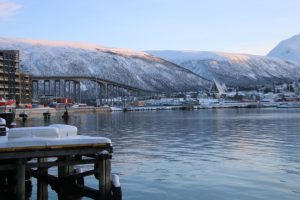We arrived in Tromsø at 08:45 with little daylight, little wind and a temperature of -5ºC. At home we would call this dawn, but work places are already open. Having passed the Arctic Circle and because of the tilt of the Earth away from the sun at this time of year we experience more darkness than light because the direct rays of the sun fall upon the Southern Hemisphere as at 12 noon the sun is overhead on the Tropic of Capricorn (23.5°S). This limited amount of sunlight is illustrated by our daily postings. On 28th January sunrise was at 08:54 and sunset at 16:46. On 29th sunrise was 09:12 and sunset 16:25. On 30th sunrise was 09:09 and sunset 15:40. On 31st sunrise 09:14 and sunset 15:04. Today sunrise was 09:24 and sunset 14:32 but the apparent position of the sun is moving northwards in readiness for spring because tomorrow the sun rises at 09:13 but doesn’t last very long and sets at 13:47. The daylight is beginning to start earlier but doesn’t last very long. The Inuit call this ‘the days when the sky falls’.
Shortly after breakfast and another rapid Covid test we were ‘layered up’ for our independent exploration of the city. Our ultimate destination was the Arctic Cathedral that previously we had seen across the fjord but had not had the time to visit.
The city is 400km north of the Arctic Circle at 69°N. It is surrounded by mountains and fjords and linked to the rest of Norway by the high, but slender Bruvegen Bridge. In earlier times Tromsø was a seal hunting, trapping and fishing centre and in the early 20th century became the starting point of Arctic and Antarctic expeditions, such as those led by Roald Amundsen. The Polar Museum preserves many artefacts and archive photographs from his expeditions. Adjacent to the ship is the Amundsen Memorial, one to Richard With, the founder of Hurtigruten and 19th century timber buildings including a cathedral, shops, merchant’s buildings as well as warehouses on the Bryggen (Trading Dock).
Merchants who were part of the Hanseatic League expanded from Germany and Bergen to here in 1536. The so-called ‘Pomor Trade’ was established in 1725. In Russian this means ‘one who lives near the sea’ and these people were from the coastline of Norway and Russia near the town of Archangelsk and a product of an idea for trade started by the British explorer and trader Richard Chancellor at the same time as his attempts to find the North East Passage to the Pacific via the north of Russia. This Pomor Trade lasted from 1740 – 1917. It was really on a ‘hiding to nothing’ because trade could only take place in summer months because the central part of the passage in Russia was icebound. The Russians traded rye flour, tar, canvas, rope, bark, wheat flour, dairy products and fine porcelain as well as fish. They specialised in the processing (as they do today with giant factory ships) the Norwegian fish. It is thought that this trade and the mixed language gave this region a unique colourful and alternative culture that maybe reflected in the Sami People’s life of today.
Having crossed the bridge we visited the Arctic Cathedral with it 11 triangles of concrete covered with steel that suggest glacial crevasses and auroral curtains as found in the Northern Lights. It was built in 1965 and is also known as the ‘Tromsdalen Church’. The stained glass east window depicts Christ descending to Earth whilst at the west end is the organ and icicle-like lights made in what was then Czechoslovakia.
We set sail around 17:30 and are heading to the North Cape, the most northerly point of the mainland of Europe.

















